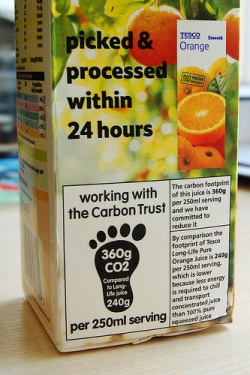

Carbon Footprint: A new way to look into old things…
 Posted on October 2, 2012 1:06 pm | Comments Off on Carbon Footprint: A new way to look into old things…
Posted on October 2, 2012 1:06 pm | Comments Off on Carbon Footprint: A new way to look into old things… 
Written by Dimitris Sotiropoulos for the Innovation Farm
 Carbon footprinting is a term directly connected in our minds with environmental protection. When we bump on a product that declares its carbon footprint, we reflectively come to the conclusion that the company which produces it takes actions against climate change and is certainly doing something good for the environment. This is something new. Companies have the opportunity to make use of this new power. Consumers are all the more aware of global climate risks and environmental challenges. Up to now, there wasn’t any symbol or reference that could create so much “buzz” and produce a direct positive message. Only save organic products, where the term itself is directly combined with “healthier”. That is innovative itself.
Carbon footprinting is a term directly connected in our minds with environmental protection. When we bump on a product that declares its carbon footprint, we reflectively come to the conclusion that the company which produces it takes actions against climate change and is certainly doing something good for the environment. This is something new. Companies have the opportunity to make use of this new power. Consumers are all the more aware of global climate risks and environmental challenges. Up to now, there wasn’t any symbol or reference that could create so much “buzz” and produce a direct positive message. Only save organic products, where the term itself is directly combined with “healthier”. That is innovative itself.
Apart from marketing though, there are more benefits in product carbon footprinting and more links to innovation. The most significant one is that it makes us see old things in a surprisingly new way.
In order to understand what is interesting about carbon footprints, we have to take a look at the way the system works. When one manufactures a product, from a fresh tomato to a highly sophisticated i-pad, you need raw materials, intermediate products, processing, distribution all the links of the supply chain. Every material that is produced, manufactured, transported produces CO2 emissions either directly or as an indirect effect. With carbon footprinting we actually calculate all these greenhouse gas emissions and divide them by the number of products that are produced in a year. Thus we end up with a product’s carbon footprint. So, if you put the end product in the middle, you have some upstream emissions and some downstream emissions that are related to it and form part of the total amount of CO2. This is all mathematics and calculations but it gives us a whole new perspective of the production process.
Take “Walkers” potato crisps for example. Walkers is a subsidiary of PepsiCo and in 2007 they have decided to measure the product’s carbon footprint, mostly because they wanted to demonstrate the company’s dedication on environmental protection and involvement in tackling climate change. When carbon footprinting was complete, they accidentally discovered that the energy consumption that was made during the frying of the potatoes process was unproportionate related to the total amount of energy spent for producing the crisps. This revealed that the problem occurred because the raw materials (fresh potatoes) where coming from the producers at a moderately high humidity rate and needed more frying time (processing) in order to become potato crisps. Walkers then asked its producers to harvest and store potatoes in a way to reduce humidity and subsequently reduced the frying time by 10% and of course the energy spent. This change made Walkers save up to 1.2 million £ per year across the supply chain and 225.000 £ directly from the electricity bill!
When you observe something from a different angle you also need a new approach to handle it. Innovation may refer to new technologies, sustainable management or a 180o degree turn to the way a company operates in order to level up with new trends and consumer expectations. In any case, to make use of a carbon footprint’s results you shall need an innovative way to make the necessary changes.






 EU Organic Farming
EU Organic Farming IFOAM
IFOAM IFOAM EU Group
IFOAM EU Group UN FAO Organic Agriculture
UN FAO Organic Agriculture